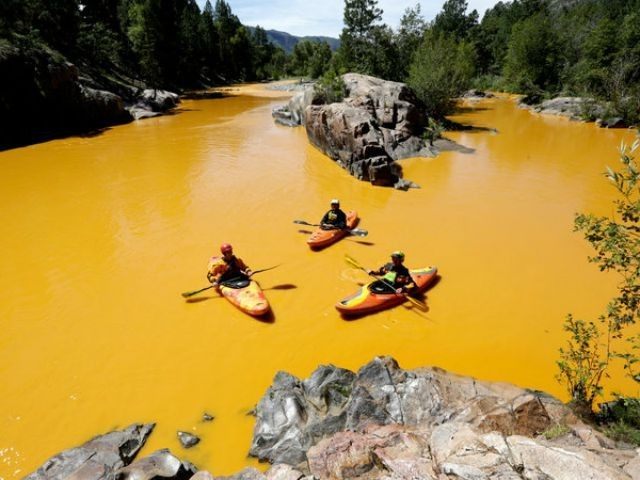Some of the major rivers and lakes of the Southwest, including the Colorado River, the San Juan River and Lake Powell, may turn polluted and dangerous after the Environmental Protection Agency badly managed a cleanup crew on Wednesday that was trying to drain water containing metals such as arsenic, lead, cadmium, aluminum, and copper from the Gold King Mine.
The operation was designed to force the water to flow into holding ponds, but the water surged, flowing into Cement Creek, then flowing into the Animas River. According to CNN, roughly one million gallons of wastewater spilled out on Wednesday. CNN reported the heavy metals released included iron, zinc, and copper.
The pellucid Animas, which supplies drinking water to the town of Durango, turned yellow as a result of the sludge, and was closed by EPA officials, who told local residents to start conserving water. Shocking pictures of the river showed how yellow it had become.
Good photo of the million gallons of polluted water flowing into Amimas River. EPA holding a public meeting at 1:30 pic.twitter.com/sWznqv28Yt
— Jennifer Brice (@CBS4Jenn) August 7, 2015
By Saturday, the sludge was traveling at 5 mph as it hit Farmington and Aztec, N.M., and threatened the San Juan and Colorado rivers and Lake Powell.
Livestock in Farmington may suffer; portable labs for testing well water have been transported to the town to test the water.
KUNC reported that the Gold King mine was only targeted for cleanup by the EPA because the agency wanted to plug the Red and Bonita Mine below it. The agency wanted to “remove the blockage and reconstruct the portal at the Gold King Mine in order to best observe possible changes in discharge caused by the installation of Red and Bonita Mine bulkhead.”
Although the flow of water has slowed from 740 gallons per minute to 548 gallons and is being guided into a holding pond, according to the EPA, the agency admitted they do not know who much water from the mine could still be emitted. The EPA said they would not know until at least Sunday if the river contains arsenic.
Shaun McGrath, regional EPA administrator for Colorado, told The Los Angeles Times, “The EPA has recognized the significance of this event and we are responding accordingly. Hopefully, we will get the results soon so we can understand the impact on agriculture, stock water, swimming, boating and human contact.” He admitted that the drainage from the mine will leave the heavy metals at the bottom of the river, and rain and runoff could cause them to rise to the surface. McGrath concluded, “We will have to do long-term monitoring and probably more closures in the future.” he said.
On Friday, David Ostrander, EPA’s director of emergency preparedness for the region, told a crowd of onlookers, “I’m very sorry. This is a huge tragedy.”
The Animas, known for its trout and wild rapids, was abandoned by the usual swimmers, fisherman, and tours by Saturday. Alex Mickel, the owner of Mild to Wild, the major rafting company in Durango, told The Times, “We are estimating $150,000 in lost revenue this month. The EPA failed to follow their own procedures — they admitted it. Now they need to help out the community economically.”

COMMENTS
Please let us know if you're having issues with commenting.